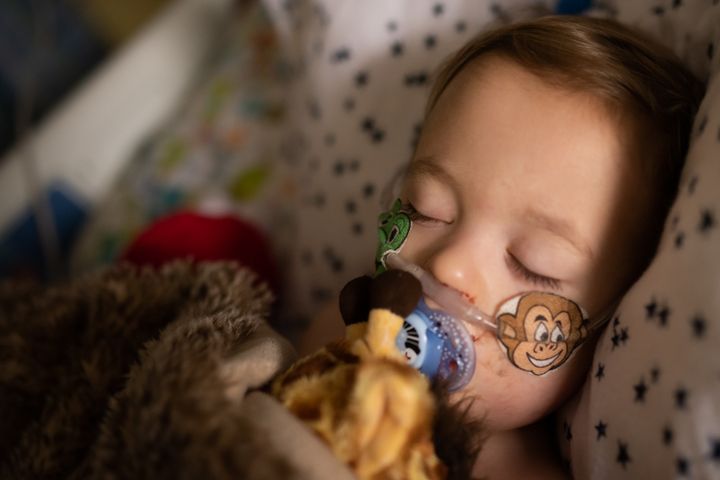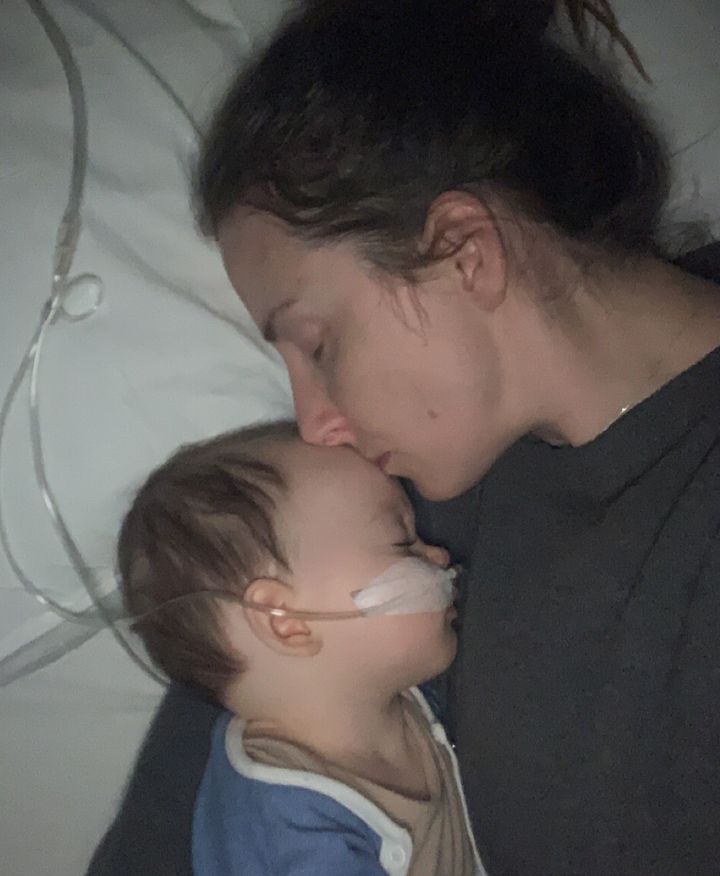
Every parent needs to have a video of their child breathing normally, suggests Tiny Hearts Education, an Instagram account teaching parents how to navigate illness and injury in children.
This is so that should their child experience respiratory distress, they’ll know it’s not normal and call for help.
It’s something Lorna Smith, 35, wishes she’d been aware of. Her son Caolan came down with RSV – or respiratory syncytial virus – when he was just eight months old.
The virus, which is incredibly common, usually causes cold-like symptoms, with most people recovering in a week or two. But in some – particularly the under-ones – it can be serious. Approximately 30,000 babies and children under five are hospitalised every year due to RSV.
“Prior to his diagnosis I had never heard of RSV and I initially thought Caolan had a virus and had to just ‘ride it out’,” Smith tells HuffPost UK.

Her son started struggling to breathe a few days into his illness. “I took him straight to the doctors where he was diagnosed with a chest infection,” Smith, who is from Southampton, recalls.
“He went downhill quickly that evening: he was chesty, had a high temperature, laboured breathing and would not feed, which was really out of character for him.”
Some children with RSV can go on to develop complications such as pneumonia and bronchiolitis. In fact, RSV is the leading cause of bronchiolitis in infants, accounting for around 60-80% of infections.
As Caolan’s symptoms progressed, Smith called NHS 111. Because he was under one and had a high temperature, an ambulance was called and he was taken to hospital where his oxygen levels – which had dropped – were then monitored.
“Due to Caolan being bunged up and chesty it was getting hard for him to feed,” Smith recalls. “They attempted to put a feeding tube in but were unsuccessful due to the amount of mucus he had, so I fed him as best as I could throughout the night.”
Thankfully his oxygen levels had improved by the following day and he was discharged to recover at home. But Smith, who works as a scientist, is now urging other parents to learn the signs of RSV ahead of winter.
She’s working with Sanofi to raise awareness through its Together Against RSV campaign. In the UK, the virus generally starts to do the rounds in October and lasts for up to five months, peaking in December.
Typical symptoms are a sore throat, runny nose, cough or fever, drowsiness, problems feeding or drinking and/or difficulty breathing, including wheezing.
“I didn’t know what laboured breathing was and was struggling to find any information,” Smith says. “I think it’s very important for parents to have access to information on RSV, to really learn what triggers requiring a doctor’s visit and calling NHS 111.”
Laboured breathing basically describes when breathing becomes difficult or impaired. This can be a sign of respiratory distress. Tiny Hearts have shared multiple videos of babies experiencing this on their Instagram page in the hope it alerts parents to what’s normal and what isn’t.
Some other key signs of respiratory distress, which requires urgent medical attention, include:
- Head bobbing
- Tracheal tug
- Altered level of consciousness
- Different breathing pattern (either faster, slower or irregular)
- Use of extra muscles to help them breathe
- Skin colour changes - around the mouth, inside of lips and fingernails might turn a blueish colour. The skin might also appear pale or grey.
- Grunting when breathing
- Nose flaring
Health experts are worried that the cost of living crisis will exacerbate RSV this year because of people being unable to afford to heat their homes. A report from University College London says rates of respiratory illness are over twice as high in kids who live in cold, damp homes.
Professor Harish Nair, an expert in paediatric infectious diseases and global health, tells HuffPost UK: “Cold and damp homes can predispose infants to a number of respiratory illnesses.
“With the cost of living increasing and many families likely to find it difficult to heat their homes this winter, children’s vulnerability to illness could be increased and this could impact the number of RSV cases significantly bringing extra strain on the NHS.”
It’s essential parents understand what RSV is and how to protect their children against it, says Prof Nair. For instance, frequent hand-washing is important, as is disinfecting surfaces and toys regularly, as the virus can survive on surfaces or objects for 4-7 hours.
Ideally, people with colds should avoid close contact with newborn babies, infants born prematurely (before 37 weeks), children under two born with heart or lung conditions, and those with weakened immune systems. Smoking around young children is also a risk factor for severe RSV infection.
If symptoms remain mild, there’s no specific treatment for RSV – rest and plenty of fluids tend to work best. Most cases clear up within two to three weeks, but parents should contact their GP or call NHS 111 if:
- Their child struggles to breath or experiences any signs of respiratory distress.
- Their child has taken less than half their usual amount during the last two or three feeds, or they have had a dry nappy for 12 hours or more.
- The child has a persistent high temperature of 37.8C or above.
- Some children under two, especially those born prematurely or with a heart condition, can suffer more serious consequences from these common respiratory infections.
An antibody treatment for RSV, called nirsevimab, has recently been approved for use in the UK. It has been shown to reduce respiratory infections caused by RSV by 75% in a trial of 4,000 babies, the BBC reported.
A large study is now underway to see if the drug should be offered to all babies in the UK. It’s hoped the drug could drastically reduce the number of those who end up in hospital as a result of the virus.